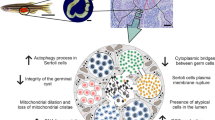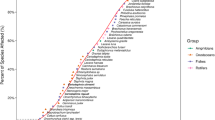Abstract
The aim of this study is to investigate the effects of the pesticides/polycyclic aromatic hydrocarbon mixture on aryl hydrocarbon receptor (AhR), p53 and ubiquitin mRNA level in haemocytes of Mya arenaria exposed to a mixture of chlorothalonil, mancozeb and benzo[a]pyrene (BaP) for 48 and 72 h. AhR, p53 and ubiquitin gene expression levels were quantified using quantitative Real-time PCR. For robust and accurate quantification of transcripts, suitable housekeeping genes were selected from four sets of ribosomal and elongation factors transcripts previously sequenced from Mya arenaria using geNorm open source software. Quantitative Real-time PCR data exhibited a significantly high expression of AhR after 72 h of exposure (P ≤ 0.05). p53 gene expression seems to be up-regulated by the mixture after 48 h, however not significantly; but the level of p53 mRNA is down-regulated by the xenobiotics between 48 and 72 h after exposure. This study postulates that AhR mRNA levels could be used as an indicator of the exposure of clams’ haemocytes to a mixture of xenobiotics such as chlorothalonil, mancozeb and BaP. However, further studies have to be pursued in order to unravel the molecular mechanisms involved in the p53 signaling pathway.





Similar content being viewed by others
References
Araya MT, Siah A, Mateo D, Markham F, McKenna P, Johnson G, Berthe FCJ (2008) Selection and evaluation of housekeeping genes for haemocytes of soft-shell clams (Mya arenaria) challenged with Vibrio splendidus. J Invertebr Pathol 99(3):326–331
Baier-Anderson CB, Anderson RS (2000) The effects of chlorothalonil on oyster haemocyte activation phagocytosis, reduced pyridine nucleotides, and reactive oxygen species production. Environ Res 83:72–78
Barber BJ (2004) Neoplastic diseases of commercially important marine bivalves. Aquat Living Resour 17:449–466
Belpogi F, Soffritti M, Guarino M, Lambertini L, Cevolani D, Maltoni C (2002) Results of long-term experimental studies on the carcinogenicity of ethylene-bis-dithiocarbamate (Mancozeb) in rats. Ann N Y Acad Sci 982:123–136
Binková B, Giguère Y, Rössner P Jr, Dostál M, Srám RJ (2000) The effect of dibenzo[a,1]pyrene and benzo[a]pyrene on human diploid lung fibroblasts: the induction of DNA adducts, expression of p53 and p21(WAF1) proteins and cell cycle distribution. Mutat Res 471(1–2):57–70
Brown DJ, Van Beneden RJ, Clark GC (1995) Identification of two binding proteins for halogenated aromatic hydrocarbons in hard-shell clam, Mercenaria mercenaria. Arch Biochem Biophys 319(1):217–224
Brzuzan P, Jurczyk L, Luczynski MK, Gora M (2006) Real-time PCR analysis of p53 mRNA levels in tissues of whitefish (Coregonus lavaretus) exposed tp benzo[a]pyrene. Pol J Vet Sci 9(2):139–143
Butler RA, Kelley ML, Powell WH, Hahn ME, Van Beneden RJ (2001) An aryl hydrocarbon receptor (AHR) homologue from the soft-shell clam, Mya arenaria: evidence that invertebrate AHR homologue lack 2,3,7,8-tetrachlorodibenzo-p-dioxin and β-naphtoflavone binding. Gene 278:223–234
Butler RA, Kelley ML, Olberding KE, Gardner GR, Van Beneden RJ (2004) Aryl hydrocarbon receptor (AhR)-independent effects of 2,3,7,8-tetrachlorodibenzo-p-dioxin (TCDD) on softshell clam (Mya arenaria) reproductive tissue. Comp Biochem Physiol 138:375–381
Calviello G, Piccioni E, Boninsegna A, Tedesco B, Maggiano N, Serini S, Wolf FI, Palozza P (2006) DNA damage and apoptosis induction by the pesticide Mancozeb in rat cells: involvement of the oxidative mechanism. Toxicol Appl Pharmacol 211:87–96
Chung KW, Chandler AR, Key PB (2008) Toxicity of carbaryl, diquat dibromide, and fluoranthene, individually and in mixture, to larval grass shrimp, Palaemonetes pugio. J Environ Sci Health B 43:293–299
Cima F, Bragadin M, Ballarin L (2008) Toxic effects of new antifouling compounds on tunicate haemocytes I. Sea-Nine 211TM and chlorothalonil. Aquat Toxicol 86:299–312
Dai M-S, Shi D, Jin Y, Sun X-X, Zhang Y, Grossman SR, Lu H (2006) Regulation of the MDM2-p53 pathway by ribosomal protein L11 involves a post-ubiquitination mechanism. J Biol Chem 281(34):24304–24313
David E, Tanguy A, Moraga D (2007) Peroxiredoxin 6 gene: a new physiological and genetic indocator of multiple environmental stress response in Pacific oyster Crassostrea gigas. Aquat Toxicol 84:389–398
Davila DR, Romero DL, Burchiel SW (1996) Human T cells are highly sensitive to suppression of mitogeneis by polycyclic aromatic hydrocarbons and this effect is differentially reversed by α-naphthoflavone. Toxicol App Pharmacol 139:333–341
Delaporte M, Synard S, Pariseau J, McKenna P, Tremblay R, Davidson J, Berthe FCJ (2008) Assessment of haemic neoplasia in different soft shell clam Mya arenaria populations from eastern Canada by flow cytometry. J Invertebr Pathol 98(2):190–197
Domico LM, Cooper KR, Bernard LP, Zeevalk GD (2007) Reactive oxygen species generation by the ethylene-bis-dithiocarbamate (EBDC) fungicide mancozeb and its contribution to neuronal toxicity in mesencephalic cells. NeuroToxicol 20:1079–1091
Gasiewicz TA, Henry EC, Collins LL (2008) Expression and activity of aryl hydrocarbon receptors in development and cancer. Crit Rev Eukaryot Gene Expr 18(4):279–321
Grevenynghe JV, Rion S, Le Ferrec E, Le Vee M, Amiot L, Fauchet R, Fardel O (2003) Polycyclic aromatic hydrocarbons inhibit differentiation of human monocytes into macrophages. J Immunol 170:2374–2381
Grevenynghe JV, Sparfel L, Vee ML, Gilot D, Drenou B, Fauchet R, Fardel O (2004) Cytochrome P450-dependent toxicity of environmental polycyclic aromatic hydrocarbons towards human macrophages. Biochem Biophys Res Commun 317:708–716
Gygi S, Rochon Y, Franza BR, Aebersold R (1999) Correlation between protein and mRNA abundance in yeast. Mol Cell Biol 19(3):1720–1730
Hellemans J, Mortier M, De Paepe A, Speleman F, Vandesompele J (2007) qBase relative quantification framework and software for management and automated analysis of real-time quantitative PCR data. Genom Biol 8:R19
Holbrook LAC, Butler RA, Cashon RE, Van Beneden RJ (2009) Soft-shell clam (Mya arenaria) p53: a structural and functional comparaison to human p53. Gene 433:81–87
Jiao S, Liu B, Gao A, Ye M, Jia X, Zhang F, Liu H, Shi X, Huang C (2008) Benzo(a)pyrene-caused increased G1-S transition requires the activation of c-Jun through p53-dependent PI-3K/Akt/ERK pathway in human embryo lung fibroblasts. Toxicol Lett 178:167–175
Ju J, Schmitz JC, Song B, Kudo K, Chu E (2007) Regulation of p53 expression in response to 5-fluorouracil in human cancer RKO cells. Clin Cancer Res 13(14):4245–4251
Kelley ML, Van Beneden RJ (2000) Identification of an E3 ubiquitin-protein ligase in the softshell clam (Mya arenaria). Mar Environ Res 50(1–5):289–293
Leaver MJ, Diab A, Boukouvala E, Williams TD, Chipman JK, Moffat CF, Robinson CD, George SG (2010) Hepatic gene expression in flounder chronically exposed to multiply polluted estuarine sediment: absence of classical exposure ‘biomarker’ signals and induction of inflammatory, innate immune and apoptotic pathways. Aquat Toxicol 96:234–245
Lee JT, Gu W (2010) The multiple levels of regulation by p53 ubiquitination. Cell Death Differ 17(1):86–92
Liu N, Pan L, Miao J, Xu C, Zhang L (2010) Molecular cloning and sequence analysis and the response of a aryl hydrocarbon receptor homologue gene in the clam Ruditapes philippinarum exposed to benzo(a)pyrene. Comp Biochem Physiol C 152:279–287
MacCallum GS, McGladdery SE, Davidson J (2003) Factors, risks and significance of emergent neoplasia in cultured and wild soft-shell clams (Mya arenaria) in Atlantic Canada. AQUANET AP-18 report, 32 p
McGladdery SE, Reinisch CL, MacCallum GS, Stephens RE, Walker CL, Davidson JT (2001) Haemic neoplasia in soft-shell clams (Mya arenaria): recent outbreaks in Atlantic Canada and discovery of a p53 gene homologue associated with the condition. Bull Aquac Assoc Can 101(3):19–26
Olberding KE, Kelley ML, Butler RA, Van Beneden RJ (2004) A HECT E3 ubiquitin-protein ligase with sequence similarity to E6AP does not target p53 for degradation in softshell clam (Mya arenaria). Mutat Res 552:61–71
Padros J, Pelletier E, Ribeiro CO (2003) Metabolic interactions between low doses of benzo[a]pyrene and tributyltin in arctic charr (Salvelinus alpinus): a long-term in vivo study. Toxicol Appl Pharmacol 192(1):45–55
Pariseau J, Saint-Louis R, Delaporte M, AboElkhair M, McKenna P, Tremblay R, Davidson TJ, Pelletier E, Berthe FCJ (2009) Potential link between exposure to fungicides chlorothalonil and mancozeb and haemic neoplasia development in soft-shell clam Mya arenaria: a laboratory experiment. Mar Pollut Bull 58(4):503–513
Reeves D (2001) Pesticides sales report. Pesticides Regulatory Program. Department of Agriculture and Forestry. Prince Edward Island
Reinisch CL, Charles AM, Stone AM (1984) Epizootic neoplasia in soft shell clams collected from New Bedford Harbor. Hazard Waste 1(1):73–81
Reno PW, House M, Illingworth A (1994) Flow cytometry and chromosome analysis of softshell clams, Mya arenaria, with disseminated neoplasia. J Invertebr Pathol 64:163–172
Reyes-Hernández OD, Mejía-García A, Sánchez-Ocampo EM, Cabañas-Cortés MA, Ramírez P, Chávez-González L, Gonzalez FJ, Elizondo G (2010) Ube2l3 gene expression is modulated by activation of the aryl hydrocarbon receptor: implications for p53 ubiquitination. Biochem Pharmacol 80(6):932–940
Rhodes LD, Gardner GR, Van Beneden R (1997) Short-term tissue distribution, depuration and possible gene expression effects of [3H]TCDD exposure in soft-shell clams (Mya arenaria). Environ Toxicol Chem 16(9):1888–1894
Ribeiro CA, Padros J, Domingos FX, Akaishi FM, Pelletier E (2007) Histopathological evidence of antagonistic effects of tributyltin on benzo[a]pyrene toxicity in the Arctic charr (Salvelinus alpinus). Sci Total Environ 372(2–3):549–553
Siah A, Masson R, Loup B, Bultelle F, Pellerin J, Leboulenger F, Danger JM (2007) Receptor activated C kinase is down-regulated in the male gonad of the marine bivalve mollusc Mya arenaria exposed to tributyltin (TBT). Aquat Toxicol 83:295–305
Siah A, Delaporte M, Pariseau J, McKenna P, Berthe FCJ (2008a) Patterns of p53, p73 and mortalin gene expression associated with haemocyte polyploidy in the soft-shell clam, Mya arenaria. J Invertebr Pathol 98(2):148–152
Siah A, Dohoo C, McKenna P, Delaporte M, Berthe FJC (2008b) Selecting a set of housekeeping genes for quantitative real-time PCR in normal and tetraploid haemocytes of soft-shell clams, Mya arenaria. Fish Shellfish Immunol 25:202–207
Snape JR, Maund SJ, Pickford DB, Hutchinson TH (2004) Ecotoxicogenomics: the challenge of integrating genomics into aquatic and terrestrial ecotoxicology. Aquat Toxicol 67:143–154
Strandberg JD, Rosenfield J, Berzins IK, Reinisch CL (1999) Specific localization of polychlorinated biphenyls in clams (Mya arenaria) from environmentally impacted sites. Aquat Toxicol 41:343–354
Toledo F, Wahl GM (2006) Regulating the p53 pathway: in vitro hypotheses, in vivo veritas. Nature Rev Cancer 6:909–923
Van Aggelen G, Ankley GT, Baldwin WS, Bearden DW, Benson WH, Chipman JK, Collette TW, Craft JA, Denslow ND, Embry MR, Falciani F, George SG, Helbing CC, Hoekstra PF, Iguchi T, Kagami Y, Katsiadaki I, Kille P, Liu L, Lord PG, McIntyre T, O’Neill A, Osachoff H, Perkins EJ, Santos EM, Skirrow RC, Snape JR, Tyler CR, Versteeg D, Viant MR, Volz DC, Williams TD, Yu L (2010) Integrating omic technologies into aquatic ecological risk assessment and environmental monitoring: hurdles, achievements, and future outlook. Environ Health Perspect 118(1):1–5
Van Benenden RJ (1997) Environmental effects and aquatic organisms: investigations of molecular mechanism of carcinogenesis. Environ Health Perspect 105(3):669–674
Vandesompele J, De Preter K, Pattyn F, Poppe B, Van Roy N, De Paepe A, Speleman F (2002). Accurate normalization of real-time quantitative RT-PCR data by geometric averaging of multiple internal control genes. Genom Biol 3(7):0034.1–0034.11
Xu D, Penning TM, Blair IA, Harvey RG (2009) Synthesis of phenol and quinine metabolites of benzo[a]pyrene, a carcinogenic component of tobacco smoke implicated in lung cancer. J Org Chem 74(2):597–604
Acknowledgments
The authors wish to thank Lise Chevarie for the soft-shell clams, Iften Redjah for the technical support and Karine Paquet for the manuscript review. This work was supported by AquaNet, NSERC, the Canada Research Chairs (CRC) Program, the Atlantic Canada Opportunities Agency (ACOA), and the Canada Foundation for Innovation (CFI).
Author information
Authors and Affiliations
Corresponding author
Rights and permissions
About this article
Cite this article
Pariseau, J., McKenna, P., AboElkhair, M. et al. Effects of pesticide compounds (chlorothalonil and mancozeb) and benzo[a]pyrene mixture on aryl hydrocarbon receptor, p53 and ubiquitin gene expression levels in haemocytes of soft-shell clams (Mya arenaria). Ecotoxicology 20, 1765–1772 (2011). https://doi.org/10.1007/s10646-011-0709-y
Accepted:
Published:
Issue Date:
DOI: https://doi.org/10.1007/s10646-011-0709-y




